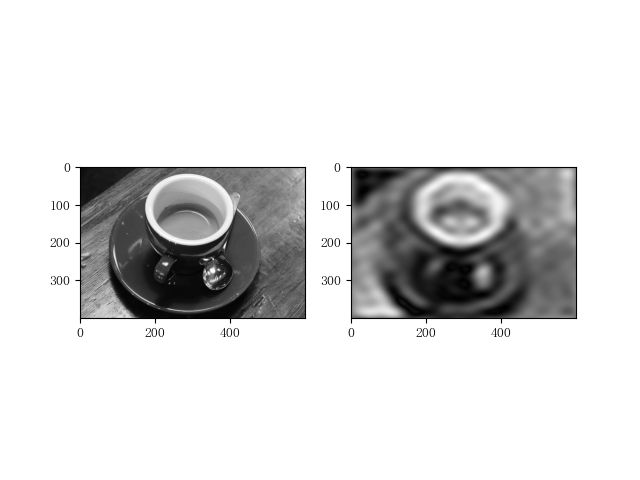复制代码
1
2
3
4
5
6
7
8
9
10
11
12
13
14
15
16
17
18
19
20
21
22
23
24
25
26
27
28
29
30
31
32
33
34
35
36
37
38
39
40
41
42
43
44
45
46
47# ldeallowpassfilter.py # 理想低通滤波器 # 导入相关库 from skimage import data, color import numpy as np import matplotlib.pyplot as plt """ 中文显示工具函数 """ def set_ch(): from pylab import mpl mpl.rcParams['font.sans-serif'] = ['FangSong'] mpl.rcParams['axes.unicode_minus'] = False set_ch() D = 10 # 读入图像 new_img = data.coffee() new_img = color.rgb2gray(new_img) # numpy中的傅里叶变换 f1 = np.fft.fft2(new_img) f1_shift = np.fft.fftshift(f1) # 使用np.fft.fftshift()函数实现平移,让直流分量输出图像的重心 # 实现理想低通滤波器 rows, cols = new_img.shape crow, ccol = int(rows/2), int(cols/2) # 计算频谱中心 mask = np.zeros((rows, cols), np.uint8) # 生成rows行cols列的矩阵,数据格式为uint8 for i in range(rows): for j in range(cols): if np.sqrt(i*i+j*j) <= D: # 将距离频谱中心小于D的部分低通信息设置为1,属于低通滤波 mask[crow-D:crow+D, ccol-D:ccol+D] = 1 f1_shift = f1_shift*mask # 傅里叶逆变换 f_ishift = np.fft.ifftshift(f1_shift) img_back = np.fft.ifft2(f_ishift) img_back = np.abs(img_back) img_back = (img_back-np.amin(img_back))/(np.amax(img_back)-np.amin(img_back)) # plt.figure(figsize=(15, 8)) plt.figure() plt.subplot(121), plt.imshow(new_img, cmap='gray') plt.subplot(122), plt.imshow(img_back, cmap='gray') plt.show()

最后
以上就是深情小鸽子最近收集整理的关于数字图像-理想低通滤波器的全部内容,更多相关数字图像-理想低通滤波器内容请搜索靠谱客的其他文章。
本图文内容来源于网友提供,作为学习参考使用,或来自网络收集整理,版权属于原作者所有。





![[数字图像处理]频域滤波(2)--高通滤波器,带阻滤波器与陷波滤波器](/uploads/reation/bcimg5.png)


发表评论 取消回复